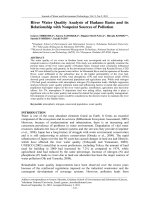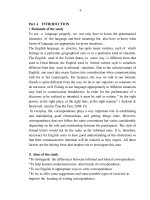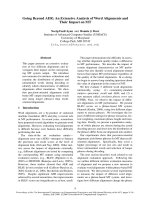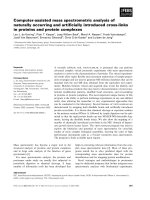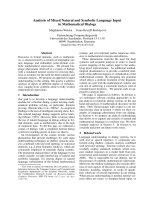Geomorphometric analysis of osman sagar and himayat sagar catchment using remote sensing and GIS
Bạn đang xem bản rút gọn của tài liệu. Xem và tải ngay bản đầy đủ của tài liệu tại đây (849.11 KB, 11 trang )
Int.J.Curr.Microbiol.App.Sci (2020) 9(3): 786-796
International Journal of Current Microbiology and Applied Sciences
ISSN: 2319-7706 Volume 9 Number 3 (2020)
Journal homepage:
Original Research Article
/>
Geomorphometric Analysis of Osman Sagar and Himayat Sagar Catchment
Using Remote Sensing and GIS
N. Gangadhar1*, G. Manojkumar1, R. Gajanan2 and Y. Siva Lakshmi3
1
Department of Soil and Water Engineering, College of Agricultural Engineering Kandi,
Sangareddy Professor Jayashankar Telangana state agricultural university (PJTSAU),
Rajendranagar, Hyderabad, India
2
Department of Water Resource Division, TRAC, Hyderabad, India
3
Department of Agronomy College of agricultural engineering Kandi, Sangareddy Professor
Jayashankar Telangana state agricultural university (PJTSAU), Rajendranagar, India
*Corresponding author
ABSTRACT
Keywords
Stream order,
Stream number,
Basin length, Mean
stream length,
Stream length
ratio, Bifurcation
ratio, Compactness
coefficient and
Rho-coefficient
Article Info
Accepted:
05 February 2020
Available Online:
10 March 2020
In the present study, analysis of geomorphometric characteristics of osman
sagar and Himayat sagar catchment was carried out using remote sensing
and GIS and the drainage networks of the both the catchment were
generated using SRTM DEM (90 m resolutions). Two adjacent catchments,
Himayath sagar and Osman sagar, located Rangareddy district of
Telangana state, India were selected for study. Morphometric features and
drainage network of Himayath sagar and Osman sagar catchments were
extracted from DEM using ArcGIS software. Such as linear parameters viz,
Stream order Stream number, basin length, mean stream length, stream
length ratio, bifurcation ratio, Compactness coefficient and Rho-coefficient
for both catchments were determined using ArcGIS.
The study of the watershed morphometric
analysis provides the beneficial parameters
for the assessment of the groundwater
potential zones, identification of sites for
water harvesting structures, water resource
management,
runoff
and
geographic
characteristics of the drainage system (Singh
et al., 2014). Morphometric is the
Introduction
Water is known as the liquid for sustenance of
life. All living beings are depending on water,
without which no life exists on the earth.
Earth has plentiful water due to the presence
of hydrological cycle on it, but most of it is
unfit for living beings use and consumption.
786
Int.J.Curr.Microbiol.App.Sci (2020) 9(3): 786-796
measurement and mathematical analysis of
the configuration of the earth's surface, shape,
dimension of its landforms (Clarke, 1996).
Morphometry represents the topographical
expression of land by way of area, slope,
shape, length, etc. These parameters affect
catchment stream flow pattern through their
influence on concentration time. River
characteristics are reasonably understood by
the morphometric analysis of that particular
river basin. Morphometric analysis requires
measurement of linear features, gradient of
channel network and contributory ground
slopes of the drainage basin.
delineation of watersheds from Digital
Elevation Models (DEM), determination of
morphometric parameters.
Study area
The study area for the present work consists
of catchment of Himayat sagar and Osman
sagar reservoirs (Fig.1). Himayat sagar
reservoir was constructed on Esa River in
1925 and is situated 9.6 km in southwest
direction from Hyderabad, located at
17º02'00" N to 17º21'15" N latitude and
77º53'49" E to 78º26'48" E longitude. Osman
sagar reservoir was constructed on Musi river
in 1922 and is situated 9.6 km from
Hyderabad in western direction located at
17º14'31" N to 17º29'50" N latitude and
77º50'30" E to 78º20'4" E longitude. The
catchment area of Himayat sagar is 1358.53
km2 with elevation range of 516 m to 730 m.
Where the Osman sagar catchment area
consists of 746.73 km2 with elevation varies
between 522 m to 722 m. Both reservoirs
supply drinking water to Hyderabad city. The
study area is pertaining to K6Dm4 AgroEcological sub region. It is part of North
Telangana Plateau, hot moist semi-arid eco
sub-region with deep loamy and clayey mixed
red and black soils having very high available
water content and 120-150 days growing
period.
The morphometric parameters are divided
into three categories: linear, areal and relief
aspects (Sreedevi et al., 2009). The
parameters namely area, perimeter, stream
order and stream length are extracted from the
geo-database and other parameters such as
bifurcation ratio, stream length ratio, Rho
coefficient, are calculated by means of
various mathematical equations (Thomas et
al., 2010).
Remote sensing techniques using satellite
images are convenient tools for morphometric
analysis. The satellite remote sensing has the
ability to provide synoptic view of large area
and is very useful in analyzing drainage
morphometry. The image interpretation
techniques are less time consuming than the
ground surveys which coupled with limited
field checks yield valuable results.
Geographical Informational System (GIS) is a
computer-assisted system designed to capture,
store, edit, display and plot geographically
referenced data.
Remote sensing data
Topographic data: Shuttle Radar Topography
Mission Digital Elevation Model (SRTM
DEM) version 4.1 with a 90 m resolution was
downloaded from .
Materials and Methods
Catchment delineation
This chapter briefly describes the details of
the study area and the material and methods
used including input parameters to achieve
the selected research objectives. The
Catchment area is delineated from a DEM by
computing the flow direction. To determine
the contributing area, a raster representing the
direction of flow is created. Once the
787
Int.J.Curr.Microbiol.App.Sci (2020) 9(3): 786-796
direction of flow out of each cell is known, it
is possible to determine which and how many
cells flow into any given cell. This
information is used to define catchment
boundaries. A series of steps are preceded to
delineate catchment and to define stream
network. A process flowchart is depicted in
Fig.2.
order does not alter the rank of the later. The
relevant numbers were entered into the
attribute table of the drainage network using
ArcGIS software
Stream order
The first step in drainage basin analysis is to
designate the stream order. Stream order is
introduced by Horton (1945). Later it is
modified by Strahler (1964). The smallest
streams of the network, which have no
tributaries, are called first order streams.
When two first order streams join together,
they form a second order stream and further
along its course this stream may join another
second order channel to form one of the third
orders and so on. A lower order stream, such
as one of the first order joining another higher
order does not alter the rank of the later. The
relevant numbers were entered into the
attribute table of the drainage network using
ArcGIS software.
Morphometric parameters estimation
Morphometric analysis is the measurement of
the three-dimensional geometry of landforms
and has traditionally been applied to
watershed, drainages, hill slopes and other
group of terrain features (Babar, 2005).
Drainage basin or basins should be the study
area for better understanding of the
hydrologic system. Basin morphometry is a
means of numerically analyzing or
mathematically quantifying aspects of
drainage channels. Spatial arrangement of
streams has given rise to a particular design
which is called the drainage pattern.
Morphometric analysis requires measurement
of linear features, gradient of channel network
and contributory ground slopes of the
drainage basin. Geographic information
system and remote sensing satellite images
are convenient tools for morphometric
analysis. To estimate the morphometric
features of catchments of Himayath sagar and
Osman sagar reservoirs, the drainage network
was extracted from digital elevation model in
ArcGIS software. Catchment areas of
Himayath sagar and Osman sagar were
extracted from SRTM DEM version 4.1, with
a 90 m resolution using hydrology tool of
ArcGIS. Geomorphometric characteristics
such as linear, areal and relief aspect
parameters for both catchments were
determined using ArcGIS. Figure 3.3 shows
methodology of geomorphometric analysis of
Himayath sagar and Osman sagar catchments.
order and so on. A lower order stream, such
as one of the first order joining another higher
Basin length
It is the distance from the outlet to the most
remote point on the basin.
Mean length
Mean length of channel of order the total
length is divided by the number of segments
of that order.
∙∙∙(i)
where, is total length of all orders;
total number of segments
is
Stream length ratio
It is the ratio of the mean length of segments
of order to the mean length segment of the
next lower order. Horton (1945
788
Int.J.Curr.Microbiol.App.Sci (2020) 9(3): 786-796
∙∙∙(ii)
∙∙∙(v)
where, is the mean length of segments of
order;
is the mean length of segments of
next order
Where, is the stream length ratio,
bifurcation ratio.
is the
Results and Discussion
Bifurcation ratio
Catchment Delineation
The term bifurcation ratio (Rb) may be
defined as the ratio of the number of the
stream segments of given order to the number
of segments of the next higher order
(Schumn,1956)
Delineation of the catchment area is the first
step of the geomorphometric analysis. The
process mentioned in section 2. is used to
delineate catchment area of Himayath sagar
and Osman sagar reservoirs. DEM is prepared
from the SRTM data of version 4.1 with a 90
m resolution. DEM of study area is depicted
in Fig.3 Flow direction raster created from
DEM is used to delineate the catchment area
(Fig.4). Catchment of Himayath sagar and
Osman sagar is presented in Fig.5. The
catchment area of Himayath sagar and Osman
sagar are 1358.53 km2 and 746.73 km2,
respectively. It is found that catchment area of
Himayath sagar is 1.82 times greater than
Osman sagar.
∙∙∙ (iii)
Where,is total no. of stream segments of order
u;
is No. of segments of next higher order
Compactness coefficient
The compactness factor was obtained from
the ratio of the perimeter of the basin to the
total drainage basin area. (Gupta, 1999)
Morphometric parameters estimation
∙∙∙(iv)
In morphometric analysis, configuration of
the earth’s surface and dimensions of the
landforms is measured. This analysis was
carried out for quantitative evaluation of
drainage basin. Three major aspects: Linear,
Areal and Relief have been described for
analysis. Linear aspect in morphometry is
characterized by basin length, stream order,
stream number, stream length and bifurcation
ratio.
Areal
aspect
represents
the
characteristics of catchment area and
describes how catchment area controls and
regulates the hydrological behavior. Relief
aspect defines terrain setup of the catchment
and
terrain
characteristics.
The
geomorphometric parameters of the Himayath
sagar and Osman sagar catchments were
Where, is the compactness factor; P is the
perimeter of the basin; A is the unit area of
the basin.
Rho-coefficient
Rho coefficient is an important parameter
described by the Horton, 1945 using the
stream length ratio divided by the bifurcation
ratio and is an important parameter relating
drainage
density
to
physiographic
development of a watershed which facilitate
evaluation of storage capacity of drainage
network and hence, a determinant of ultimate
degree of drainage development in a
givenwatershed.
789
Int.J.Curr.Microbiol.App.Sci (2020) 9(3): 786-796
carried out using SRTM DEM with 90 m
spatial resolution. Examined parameters are
presented in detailed in following sections.
Mean stream length of study catchments is
calculated as ratio of total length of all
streams to number of streams. Mean stream
length of Himayath sagar and Osman sagar
catchment is 1354.73 km and 789.16 km,
respectively. Main stream length of Himayath
sagar and Osman sagar catchments are 65.76
km and 58.89 km, respectively. The time of
concentration along main stream is always
greatest. Stream length ratio of Himayath
sagar and Osman sagar catchment is 1.263
and 0.474, respectively. Generally, its value
of the given order is greater than that of the
lower order and less than that of its next
higher order. Changes in stream length ratio
from one order to another indicate the late
youth to mature stage of the geomorphic
development (Singh and Singh, 1997).
Bifurcation ratio is an index of relief and
dissection (Horton, 1945 and Schumm, 1956).
Bifurcation ratio of Himayath sagar
catchment varies from 2.0 to 4.87 and mean
bifurcation ratio is 3.78. Bifurcation ratio of
the Osman sagar catchment varies from 3.11
to 7.00 and mean bifurcation ratio is 4.5.
Table 1 presents bifurcation ratio analysis for
both catchments. It has been found that the
mean bifurcation ratio characteristically
ranges between 3.78 and 4.5 for both
catchments.
Stream ordering has been carried out using
Strahler method (1964). Stream order of the
study area of Himayath sagar ranges from 1 to
7. Whereas the stream order for Osman sagar
varies from 1 to 6. Figure 6 shows stream
order map of both catchment. It is observed
that the maximum frequency is in the case of
first order streams and there is a decrease in
stream frequency as the stream order
increases.
Basin length is the distance from the outlet to
the most remote point on the basin. Length of
the basin of Himayath sagar catchment is
52.92 km whereas the length of the basin of
Osman sagar catchment is 50.49 km. Stream
length is computed based on the Horton law
(1945). The total stream length of Himayath
sagar catchment is 2592.96 km whereas the
total stream length of the basin for Osman
sagar catchment is 1510.46 km. It is found
that Ist order streams have the maximum
length compared to that of other orders.
Stream length decreases as stream order
increases. Stream length against stream order
is shown in Fig. 7
Table.1 Table .1Bifurcation ratio analysis for Himayath sagar and Osman sagar catchments
Stream
order
1
2
3
4
5
6
7
Himayath sagar
No of streams Bifurcation
ratio
2318
605
3.83
129
4.68
39
3.30
7
4.87
2
4.00
1
2.00
Mean
3.78
790
Osman sagar
No of streams
Bifurcation
ratio
1439
355
4.05
87
4.08
28
3.11
4
7.00
1
4.00
4.45
Int.J.Curr.Microbiol.App.Sci (2020) 9(3): 786-796
Fig.1 Location of study area
791
Int.J.Curr.Microbiol.App.Sci (2020) 9(3): 786-796
Fig.2 Flow chart for catchment delineation
Fig.3 Digital elevation model representation of study area
792
Int.J.Curr.Microbiol.App.Sci (2020) 9(3): 786-796
Fig.4 Flow direction map of study area
Fig.5 Catchment of Himayath sagar and Osman sagar reservoirs
793
Int.J.Curr.Microbiol.App.Sci (2020) 9(3): 786-796
Fig.6 Stream order map of Himayath sagar and Osman sagar catchments
Fig.7 Stream length and stream order of Himayath sagar and Osman sagar catchments
Bifurcation ratio with low value means no
structural disturbances and a high value
means the existence of strong structural
control on the catchment. Mean bifurcation
ratio of less than 5 for study area shows that
geology is reasonably homogeneous without
structural disturbances to the drainage basin.
1.980 and 2.316, respectively. It reflects that
Himayath sagar catchment have less
elongated shape than Osman sagar catchment.
However, both catchments has high time of
concentration of surface flow. Rho coefficient
of Himayath sagar and Osman sagar
catchment is 0.33 and 0.12, respectively. Rho
coefficient of both catchments indicates low
storage capacity of drainage network and
hydrologic storage during floods.
Compactness coefficient of Himayath sagar
and Osman sagar catchment is found to be
794
Int.J.Curr.Microbiol.App.Sci (2020) 9(3): 786-796
Summary and conclusions of the study are as
follows:
1. A GIS technique characterized by very
high accuracy of mapping and
measurement proves a competent tool in
geomorphometric analysis.
Growing population, urbanization and
industrialization are leading to overutilization of water resources, thus exerting
pressure on the limited civic amenities many
of which are on the brink of collapse.
Assessment of water resources quantitatively
is being critical task on account of everincreasing demand for water over past. Water
plays principal role in the sustainability of
livelihoods,
agriculture
and
regional
economy. Water management is the primary
safeguard against drought and plays a
fundamental role in achieving food security at
the watershed, sub basin and basin from local
to globalplanes. The study of the watershed
morphometric analysis provides the beneficial
parameters for the assessment of the
groundwater potential zones, identification of
sites for water harvesting structures, water
resource management, runoff and geographic
characteristics of the drainage system.
2. Geomorphometric analysis shows both
catchment areas have elongated shape
and high time of concentration of surface
flow.
3. Mean bifurcation ratio of less than 5 for
both catchments shows geology is
reasonably homogeneous.
References
Chopra, R., Dhiman, R. D., and Sharma, P. K.
2005. Morphometric analysis of subwatersheds in Gurdaspur district,
Punjab using remote sensing and GIS
techniques. Journal of the Indian
Society of Remote Sensing, 33(4), 531.
Chopra, R., Dhiman, R. D., and Sharma, P. K.
2005. Morphometric analysis of subwatersheds in Gurdaspur district,
Punjab using remote sensing and GIS
techniques. Journal of the Indian
Society of Remote Sensing. 33(4):531539
Clarke, J.I. (1996), Morphometry from Maps,
Essays in Geomorphology, Elsevier
publication. Co, New York, pp 235274.
Farhan, Y., Anbar, A., Enaba, O., and AlShaikh, N. 2015. Quantitative analysis
of geomorphometric parameters of
WadiKerak, Jordan, using remote
sensing and GIS. Journal of Water
Resource and Protection. 7(06): 456475
Horton, R. E. 1945. Erosional development of
streams and their drainage basins;
hydrophysical approach to quantitative
morphology. Geological society of
Americabulletin,56(3), 275-370.
Kiran Kumar, K. M., Govindaiah, S., and
Nagabhushan, P. 2017. Morphometric
Morphometry represents the topographical
expression of land by way of area, slope,
shape, length, etc. These parameters affect
catchment stream flow pattern through their
influence on concentration time. River
characteristics are reasonably understood by
the morphometric analysis of that particular
river basin. Morphometric analysis requires
measurement of linear features, gradient of
channel network and contributory ground
slopes of the drainage basin. Considering the
above facts, the present study focuses on the
analysis of geomorphometric characteristics
in the two adjacent catchments. The specific
objectives of the study are as follows to
analyse geomorphometric characteristics of
Himayath sagar and Osman sagar catchment
using RS and GIS. Particular to the present
study, the following salient conclusions are
drawn.
795
Int.J.Curr.Microbiol.App.Sci (2020) 9(3): 786-796
Analysis
of
the
Tumkur-Gubbi
Watershed of Shimsha River Basin,
Karnataka, India, by using Remote
Sensing
and
GIS
Techniques.
International Journal of Creative
Research Thoughts (IJCRT).6(1):16281640
Pareta, K., and Pareta, U. 2012. Quantitative
geo morphological analysis of a
watershed of Ravi River Basin, HP
India. International Journal of Remote
Sensing and GIS.1(1): 41-56.
Singh, P., Gupta, A., and Singh, M. (2014).
Hydrological inferences from watershed
analysis for water resource management
using remote sensing and GIS
techniques. The Egyptian Journal of
Remote Sensing and Space Science,
17(2), 111-121.
Soni, S. K., Tripathi, S., and Maurya, A. K.
2013. GIS based morphometric
characterization of mini-watershed—
Rachhar Nala of Anuppur District
Madhya Pradesh. International Journal
of
Advanced
Technology
and
Engineering
Research
(IJATER).
3(3):32-38.
Sreedevi, P. D., Owais, S., Khan, H. H. and
Ahmed, S. 2009. Morphometric
analysis of a watershed of South India
using SRTM data and GIS. Journal of
the geological society of India.
73(4):543-552.
Strahler, A. N. 1957. Quantitative analysis of
watershed
geomorphology.
Eos,
Transactions American Geophysical
Union, 38(6), 913-920.
Thomas, J., Joseph, S. and Thrivikramaji, K.
P. 2010. Morphometric aspects of a
small tropical mountain river system,
the southern Western Ghats, India.
International Journal of Digital Earth.
3(2): 135-156.
V. E. 2015. Morphometric evaluation of
watersheds in Caxias do Sul City,
Brazil, using SRTM (DEM) data and
GIS. Environmental Earth Sciences.
73(9): 5677-5685.
Varalakshmi, V. 2015. Morphometric analysis
of the Catchments of Himayatsagar and
Osmansagar
Reservoirs-Hyderabad.
Engineering and Scientific International
Journal, 2(1),
Vieceli, N., Bortolin, T. A., Mendes, L. A.,
Bacarim, G., Cemin, G., and Schneider,
Vittala, S. S., Govindaiah, S., and Gowda, H.
H. 2004. Morphometric analysis of subwatersheds in the Pavagada area of
Tumkur district, South India using
remote sensing and GIS techniques.
Journal of the Indian Society of Remote
Sensing. 32(4): 351-362.
How to cite this article:
Gangadhar, N., G. Manojkumar, R. Gajanan and Siva Lakshmi, Y. 2020. Geomorphometric
Analysis of Osman Sagar and Himayat Sagar Catchment Using Remote Sensing and GIS.
Int.J.Curr.Microbiol.App.Sci. 9(03): 786-796. doi: />
796

